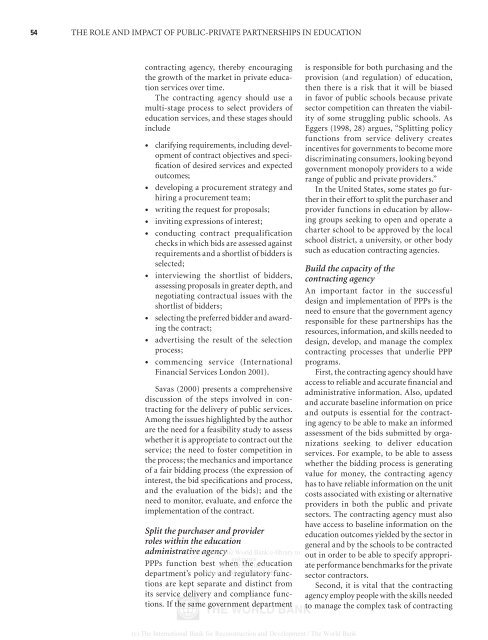The Role and Impact of Public-Private Partnerships in Education
The Role and Impact of Public-Private Partnerships in Education
The Role and Impact of Public-Private Partnerships in Education
Create successful ePaper yourself
Turn your PDF publications into a flip-book with our unique Google optimized e-Paper software.
54 THE ROLE AND IMPACT OF PUBLIC-PRIVATE PARTNERSHIPS IN EDUCATION<br />
contract<strong>in</strong>g agency, thereby encourag<strong>in</strong>g<br />
the growth <strong>of</strong> the market <strong>in</strong> private education<br />
services over time.<br />
<strong>The</strong> contract<strong>in</strong>g agency should use a<br />
multi-stage process to select providers <strong>of</strong><br />
education services, <strong>and</strong> these stages should<br />
<strong>in</strong>clude<br />
• clarify<strong>in</strong>g requirements, <strong>in</strong>clud<strong>in</strong>g development<br />
<strong>of</strong> contract objectives <strong>and</strong> specification<br />
<strong>of</strong> desired services <strong>and</strong> expected<br />
outcomes;<br />
• develop<strong>in</strong>g a procurement strategy <strong>and</strong><br />
hir<strong>in</strong>g a procurement team;<br />
• writ<strong>in</strong>g the request for proposals;<br />
• <strong>in</strong>vit<strong>in</strong>g expressions <strong>of</strong> <strong>in</strong>terest;<br />
• conduct<strong>in</strong>g contract prequalification<br />
checks <strong>in</strong> which bids are assessed aga<strong>in</strong>st<br />
requirements <strong>and</strong> a shortlist <strong>of</strong> bidders is<br />
selected;<br />
• <strong>in</strong>terview<strong>in</strong>g the shortlist <strong>of</strong> bidders,<br />
assess<strong>in</strong>g proposals <strong>in</strong> greater depth, <strong>and</strong><br />
negotiat<strong>in</strong>g contractual issues with the<br />
shortlist <strong>of</strong> bidders;<br />
• select<strong>in</strong>g the preferred bidder <strong>and</strong> award<strong>in</strong>g<br />
the contract;<br />
• advertis<strong>in</strong>g the result <strong>of</strong> the selection<br />
process;<br />
• commenc<strong>in</strong>g service (International<br />
F<strong>in</strong>ancial Services London 2001).<br />
Savas (2000) presents a comprehensive<br />
discussion <strong>of</strong> the steps <strong>in</strong>volved <strong>in</strong> contract<strong>in</strong>g<br />
for the delivery <strong>of</strong> public services.<br />
Among the issues highlighted by the author<br />
are the need for a feasibility study to assess<br />
whether it is appropriate to contract out the<br />
service; the need to foster competition <strong>in</strong><br />
the process; the mechanics <strong>and</strong> importance<br />
<strong>of</strong> a fair bidd<strong>in</strong>g process (the expression <strong>of</strong><br />
<strong>in</strong>terest, the bid specifications <strong>and</strong> process,<br />
<strong>and</strong> the evaluation <strong>of</strong> the bids); <strong>and</strong> the<br />
need to monitor, evaluate, <strong>and</strong> enforce the<br />
implementation <strong>of</strong> the contract.<br />
Split the purchaser <strong>and</strong> provider<br />
roles with<strong>in</strong> the education<br />
adm<strong>in</strong>istrative Delivered agency by <strong>The</strong> World Bank e-library to:<br />
unknown<br />
PPPs function best IP when : 192.86.100.35 the education<br />
department’s policy Mon, <strong>and</strong> 30 Mar regulatory 2009 12:16:23 functions<br />
are kept separate <strong>and</strong> dist<strong>in</strong>ct from<br />
its service delivery <strong>and</strong> compliance functions.<br />
If the same government department<br />
is responsible for both purchas<strong>in</strong>g <strong>and</strong> the<br />
provision (<strong>and</strong> regulation) <strong>of</strong> education,<br />
then there is a risk that it will be biased<br />
<strong>in</strong> favor <strong>of</strong> public schools because private<br />
sector competition can threaten the viability<br />
<strong>of</strong> some struggl<strong>in</strong>g public schools. As<br />
Eggers (1998, 28) argues, “Splitt<strong>in</strong>g policy<br />
functions from service delivery creates<br />
<strong>in</strong>centives for governments to become more<br />
discrim<strong>in</strong>at<strong>in</strong>g consumers, look<strong>in</strong>g beyond<br />
government monopoly providers to a wide<br />
range <strong>of</strong> public <strong>and</strong> private providers.”<br />
In the United States, some states go further<br />
<strong>in</strong> their effort to split the purchaser <strong>and</strong><br />
provider functions <strong>in</strong> education by allow<strong>in</strong>g<br />
groups seek<strong>in</strong>g to open <strong>and</strong> operate a<br />
charter school to be approved by the local<br />
school district, a university, or other body<br />
such as education contract<strong>in</strong>g agencies.<br />
Build the capacity <strong>of</strong> the<br />
contract<strong>in</strong>g agency<br />
An important factor <strong>in</strong> the successful<br />
design <strong>and</strong> implementation <strong>of</strong> PPPs is the<br />
need to ensure that the government agency<br />
responsible for these partnerships has the<br />
resources, <strong>in</strong>formation, <strong>and</strong> skills needed to<br />
design, develop, <strong>and</strong> manage the complex<br />
contract<strong>in</strong>g processes that underlie PPP<br />
programs.<br />
First, the contract<strong>in</strong>g agency should have<br />
access to reliable <strong>and</strong> accurate f<strong>in</strong>ancial <strong>and</strong><br />
adm<strong>in</strong>istrative <strong>in</strong>formation. Also, updated<br />
<strong>and</strong> accurate basel<strong>in</strong>e <strong>in</strong>formation on price<br />
<strong>and</strong> outputs is essential for the contract<strong>in</strong>g<br />
agency to be able to make an <strong>in</strong>formed<br />
assessment <strong>of</strong> the bids submitted by organizations<br />
seek<strong>in</strong>g to deliver education<br />
services. For example, to be able to assess<br />
whether the bidd<strong>in</strong>g process is generat<strong>in</strong>g<br />
value for money, the contract<strong>in</strong>g agency<br />
has to have reliable <strong>in</strong>formation on the unit<br />
costs associated with exist<strong>in</strong>g or alternative<br />
providers <strong>in</strong> both the public <strong>and</strong> private<br />
sectors. <strong>The</strong> contract<strong>in</strong>g agency must also<br />
have access to basel<strong>in</strong>e <strong>in</strong>formation on the<br />
education outcomes yielded by the sector <strong>in</strong><br />
general <strong>and</strong> by the schools to be contracted<br />
out <strong>in</strong> order to be able to specify appropriate<br />
performance benchmarks for the private<br />
sector contractors.<br />
Second, it is vital that the contract<strong>in</strong>g<br />
agency employ people with the skills needed<br />
to manage the complex task <strong>of</strong> contract<strong>in</strong>g<br />
(c) <strong>The</strong> International Bank for Reconstruction <strong>and</strong> Development / <strong>The</strong> World Bank
















